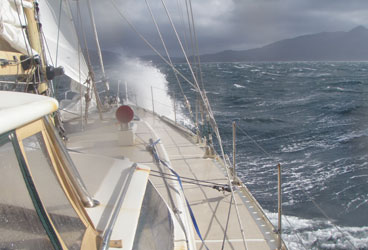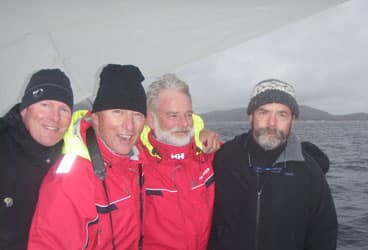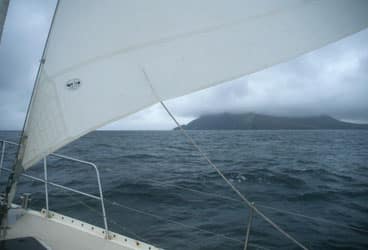
Herb McCormick| |Plowing to weather a day out from rounding Cape Horn, Ocean Watch was lashed by a 55-knot gale before the weather took a turn for the better.| When skipper Mark Schrader conceived of our voyage Around the Americas, he sat down and drew up an itinerary in a clockwise direction, beginning and ending in Seattle, Washington. From the outset, I realized this would have some challenging ramifications, particularly bucking the contrary northerly flow of the Gulf Stream and the Brazilian Current after a transit through the Northwest Passage. But the biggest potential issue of them all would be a rare east-to-west rounding of Cape Horn, against the prevailing westerly winds in the high southern latitudes. So when we hauled the anchor in a little cove on an island called Isla Wollaston – just a few miles north of Isla Hornos: Cape Horn – at precisely 0500, I could hardly believe our good fortune.
It was blowing out of the east.
We’d enjoyed a fast and efficient run from the Falkland Islands to Puerto Williams, Chile, hard by the Beagle Channel, where we picked up a couple of new crew members – David Rockefeller, Jr. and David Treadway, co-founders of Sailors for the Sea, one of the primary backers of the expedition Around the Americas (www.aroundtheamericas.org). The original idea was to take a short breather before heading south towards the Horn, but the extended forecast called for a series of severe westerly gales that would slam shut the weather window if we didn’t act fast. A few hours after arriving in Puerto Williams, we were again underway, this time for Cape Horn.

Herb McCormick| |With Cape Horn in the distance, the permanent crew aboard Ocean Watch — David Thoreson, Herb McCormick, Mark Schrader and Dave Logan — can breathe a sigh of relief.|
The great Cape itself rests on the southern terminus of a rugged archipelago less than a hundred miles south of Puerto Williams, and our new plan was to make for the islands with dispatch, find a place to hide, and be ready to go when the weather cooperated. The sail southward was wet and wild, as Ocean Watch was buffeted by northwest winds that peaked at over 50-knots; that same afternoon, the lighthouse keeper at the Horn recorded a gust that topped a hundred knots. But we’d reached a quiet inlet in advance of the worst of the blow, and hunkered down there to stage our final assault on the Horn.
Thirty-six hours (and one new anchorage) later, we set a course for Cape Horn. In honesty, if the wind hadn’t cooperated, we were ready to round it from west-to-east – to “wear ship,” if you will, before backtracking and heading east. But the easterly breeze that filled in was icing on the cake, and we made way for the Horn on the same heading Mark had dreamed about when he drew that first circle around the American continents.

Herb McCormick| |On a gray, misty, fitting morning, Ocean Watch reached past Cape Horn to starboard before a rare easterly breeze.|
At the stroke of 0800, all out figurative stars fell into alignment: we were precisely at 56 degrees South, some 18,300 nautical miles into the voyage, and sailing fast before an ideal 20-knot southeasterly breeze. At that juncture, Mark made a surprising call: “Hoist the spinnaker!” We rigged and set our big, white kite, emblazoned with a representation of North and South America. It was the highlight of the day.
Soon after, a squall appeared, and we doused the sail as quickly as we’d raised it. Anyway, the Horn was behind us and it was time to change course. For the first time in months, we are headed north.








